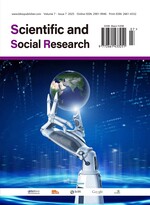The Impact of Big Data on News Selection, Production, and Distribution
Abstract
Big data is profoundly changing the news industry’s production logic and dissemination mode. Nowadays, the media increasingly rely on data mining, machine learning, and user behavior analysis to accurately predict audience concerns and optimize content presentation. The rise of data-driven journalism has enabled media outlets to adjust their topic selection strategies based on real-time data, increase the appeal of their stories, and improve production efficiency and scale through automation. However, this model is not without its drawbacks. Traffic orientation may lead media to cater to algorithmic recommendations overly, undermine in-depth reporting, and even contribute to the proliferation of emotional and vulgar content. In contrast, the role of big data in news dissemination is more intuitive. Precision communication allows media to customize news distribution based on audience reading habits and interests, improve user engagement and information reach efficiency, and enhance the social impact of news. This paper will discuss how big data reshapes news selection and content production and analyze its challenges and pitfalls.
References
Bai H, Zhang T, 2022, Understanding Data Journalism as Knowledge: An Investigation Based on Journalism Epistemology. China News Review, 3(3): 74–82. https://cics.fudan.edu.cn/2e/49/c40201a667209/page.htm?utm_source=chatgpt.com
Bambrick J, Xu M, Almonte A, et al., 2020, NSTM: Real-Time Query-Driven News Overview Composition at Bloomberg. https://arxiv.org/pdf/2006.01117
Chen Z, Wang P, 2016, Characteristics and Issues of Data Journalism in Chinese News Websites. Chinese Journal of Journalism & Communication, 38(6): 45–58.
Kasica S, Berret C, Munzner T, 2020, Table Scraps: An Actionable Framework for Multi-Table Data Wrangling From An Artifact Study of Computational Journalism. IEEE Transactions on Visualization and Computer Graphics. https://arxiv.org/pdf/2009.02373
Liu B, Niu D, Lai K, et al., 2018, Growing Story Forest Online from Massive Breaking News. https://arxiv.org/pdf/1803.00189
Lan T, 2022, A New Way to Construct the Value of Data News: From Topic Selection Expansion to Visual Presentation — A Case Study of “Surging Beauty Mathematics Course. China News Review, 3(3): 74–82. https://doi.org/10.35534/cnr.0303008
Li S, 2021, The Impact of Big Data Algorithms on Media Audiences. Advances in Social Sciences, 10(9): 2705–2709. https://doi.org/10.12677/ASS.2021.109371
Liu J, Dolan P, Pedersen ER, 2010, Personalized News Recommendation Based on Click Behavior. Proceedings of the 15th International Conference on Intelligent User Interfaces, 31–40.
Meng F, 2023, Research on Innovative Strategies for News Editing in the Era of Big Data. Electronics, Communication and Computer Science, 5(2): 88–90.
Morini F, 2025, Different yet Complementary: A Systematic Literature Review on Data Journalism in Visualization Research and Journalism Studies. Journalism, 26(2): 425–444. https://doi.org/10.1177/14648849241237897
Qiu D, Geng H, 2023, An Analysis of the Impact of Big Data Technology Application on Human Thinking Quality. Journal of Dialectics of Nature, 45(9): 81–88. https://doi.org/10.15994/j.1000-0763.2023.09.011
Veglis A, Saridou T, Panagiotidis K, et al., 2022, Applications of Big Data in Media Organizations. Social Sciences, 11(9): 414. https://doi.org/10.3390/socsci11090414
Zhou Q, Liang J, Xu X, 2021, A Comparative Study on Data Journalism Research and Practice at Home and Abroad—Based on Bibliometric and Content Analysis. Journal of Literature and Data Science, 3(2): 47–64. https://wxysjxb.ajcass.com/Admin/UploadFile/Issue/201902190001/2021/7//20210713020210WU_FILE_0.pdf?utm_source=chatgpt.com

